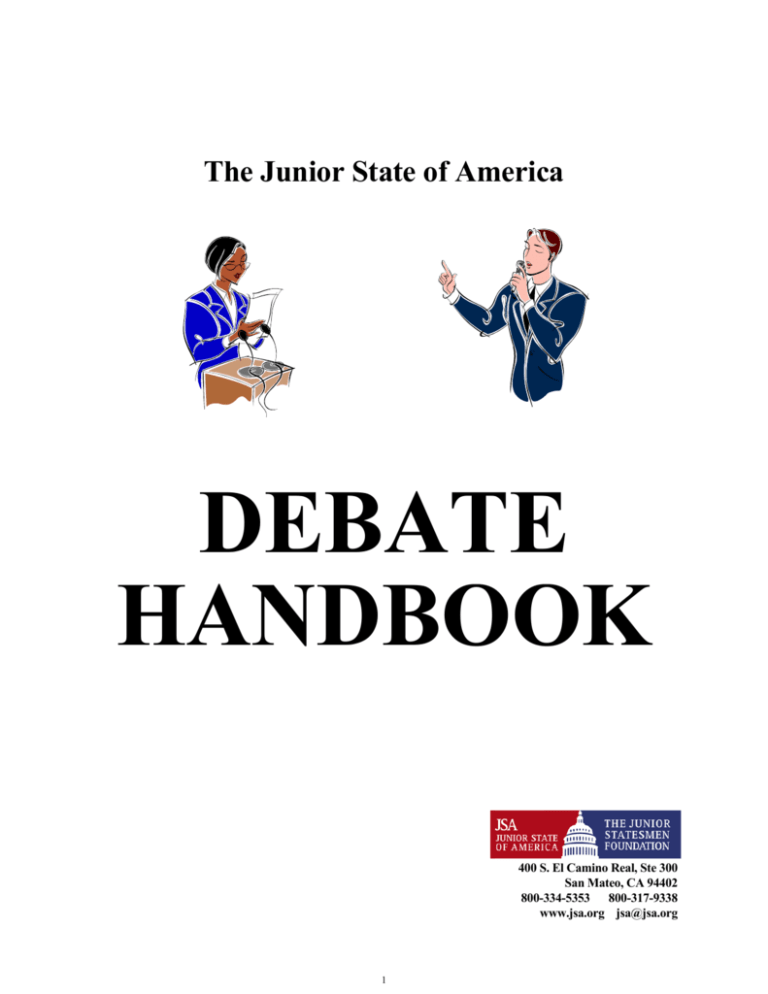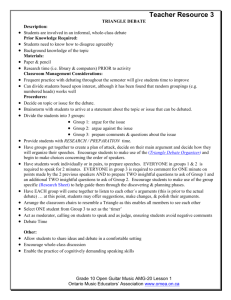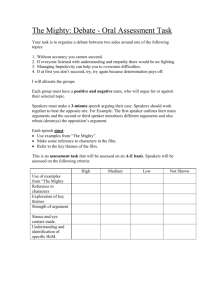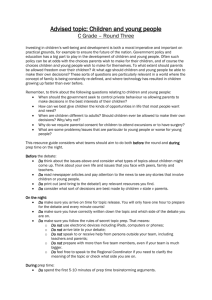Debate Handbook - JSA - Junior State of America
advertisement

The Junior State of America DEBATE HANDBOOK 400 S. El Camino Real, Ste 300 San Mateo, CA 94402 800-334-5353 800-317-9338 www.jsa.org jsa@jsa.org 1 Debate Handbook In a world full of endless problems and conflicting opinions, the art of debate is a very valuable tool. The Junior State recognizes this and makes debate an integral part of its program. Many new Junior State members are inexperienced in the field of debate. This handbook was created as a learning tool. It will present to you the fundamentals of parliamentary procedure and JSA debate. After reading this handbook, you will feel confident enough to express yourself in the debate framework. Remember, all views and arguments on the subject at hand are valid if well thought out. In expressing your opinion, you have nothing to lose, so speak up!! TRADITIONAL JSA DEBATE PROCEDURE First, the moderator reads the debate resolution. A possible resolution might be: RESOLVED, that the private ownership of handguns be banned. The debate begins with six minute opening speeches from the main speaker in favor of the resolution (the proponent) and the main speaker against the resolution (the opponent). These two persons have been selected in advance and have prepared their speeches. It is their job to research the debate topic and summarize the key arguments in favor of their position as they see them. For example, the main proponent for the above resolution might expand on three main arguments: I. II. III. Handguns have no purpose other than to kill people. Crimes of passion will be fewer if handguns are not available. Only banning handguns will solve the problem; gun registration is not enough. If there is any time left after the main speaker has finished speaking, the speaker may: 1) yield the remaining time to questions (take questions from the floor); or 2) yield the time to the chair (time forfeited). After the proponent's time has lapsed, the opponent gives a six minute opening speech. The opponent might begin by offering new arguments to the debate: I. II. We need guns for the protection of our property. Owning a gun is a constitutional right. Then the opponent should respond to or “refute” the proponent's major points: III. IV. V. Handguns can be used for hunting. Knives and other weapons will still be available to kill with. Gun registration can help find the owner of a crime gun. When the opponent is finished expressing his point of view, he also may: 1) yield the remaining time to questions (take questions from the floor); or 2) yield the time to the chair (time forfeited). 2 After the main speeches are finished, the moderator will ask for subsequent speeches from the audience. These speeches alternate between affirmative and negative, beginning with the affirmative. Unless otherwise stated, these may be a maximum of three minutes in length. Anyone, except the moderator, may speak. If no one else wishes to speak on a certain side, the main speaker on that side may be recognized. As an example (once again with the above resolution), the subsequent speaker might state: 1)A new argument: Gun control seems to work in the various cities in which it is being used. A handgun ban should be expanded nationwide. 2)A new fact supporting an old argument: According to the FBI Uniform Crime Report of 2005, some 68% of all murders with handguns are crimes of passion. 3)A new way of looking at an old argument: Gun registration is not enough; we need the strongest possible gun control. 4)Rebutting an opponent’s argument: Knives are less likely to kill than handguns. 5)A combination of all of the above. At the end of the subsequent speech, the speakers may: a) yield their time to questions; b) yield their time to the chair; c) yield their time to another subsequent speaker (on the same side); or d) yield their time to the main speaker (on the same side). After the alternating speeches, an appropriate motion (the previous question) is passed, or when the time limitation set for the debate expires, subsequent speeches will be discontinued and the main speakers will each give a closing speech. Closing speeches begin with the opponent, followed by the proponent. These speeches should reemphasize and defend the most important arguments brought up by each side. The speakers should try to present the overall philosophy of their position, reiterate the best arguments on their side and refute the most damaging arguments brought up by their opponents. Keep in mind, the words spoken last have the greatest impact and are usually best remembered by the audience. If time remains after the conclusion of either closing speech, the speaker must yield his time to the chair. Following the closing speeches, the audience immediately votes on the resolution, and the results are announced. RESEARCH The first step to good preparation is being able to find sources of information on a particular issue. There are several ways of doing research. Here are a couple of places to start: 3 1. The Web: The Web provides an incredible array of resources on every imaginable topic. However, since anyone can create a website, the most important thing is to establish the credibility of your sources. Most major newspaper websites, such as www.nytimes.com for the New York Times and http://online.wsj.com/public/us for the Wall Street Journal may be considered reliable and provide internal search engines. Other news organizations, such as www.cnn.com provide the same service. Sometimes, you may have to create an account but these are usually free. General search engines such as Google and Yahoo can also be useful. Both have News pages where you can search for news stories specifically associated with your topic. One guide to researching on-line can be found at http://www.webliminal.com/search/. 2. The Library: Every library contains the Reader's Guide to Periodical Literature which indexes magazine articles by subject. The Reader's Guide concentrates primarily on the most widely read publications (Time, Newsweek, U.S. News and World Report, etc.), but also some less read titles (America, Nation, etc.). It is usually the best source for researching a debate. However, if you wish to obtain a more in-depth survey of a subject, you may prefer periodical indexes such as Social Sciences and Humanities or Public Affairs Information Service (P.A.I.S.). These indexes will classify magazines of a more specified nature (i.e. New England Journal of Medicine and government publications). These helpful guides are highly recommended if the information you seek is not found in the Reader's Guide. 3. Your Own Ingenuity: Research organizations and politicians dedicated to your issue. What are their main arguments and campaigns? Maybe you can get a quote in support of your argument directly from a politician supporting your argument! ORGANIZING YOUR MAIN SPEECH Every speech should have some organizational structure. This helps the audience follow along with what you are saying. More importantly, it helps you arrange your arguments for maximum impact. One simple organizational structure looks like this: I. II. III. IV. V. Introduction and preview of arguments. In this simple structure, the speaker gives an attention getting introduction that: a. Lets the audience know why the issue at hand is important. b. Provides a definition for the audience of resolution so everyone understands the issue. c. Gives a quick summary of three main arguments that the speaker will use to gain support from the audience. Main point #1. Think of the main points as the answer to the question, “why?” For example in our sample resolution, the answer to the question, “Why should handguns be banned?” helps us form our first main point: “Because the only use for handguns is to shoot other people.” Each main point should be supported by some type of evidence. Main point #2 Main point #3 Conclusion. Review your main points, refute your opponent’s best arguments and make a final appeal for votes. 4 In this simple structure, you should arrange your main points so that your best argument is either Main point #1 or Main point #3 – either first or last. “Be aware that people will remember what you say first (the primary principle) and what you say last (the recency principle). In light of this, it is logical that arranging your arguments either from weakest to strongest (climax) or from strongest to weakest (anticlimax) would be more effective than placing your best points in the middle (pyramidal)” -- From The Speakers Handbook, Sprague and Stuart Another organizational structure relies on a psychologically based format developed in the 1930’s by Alan Monroe. Known as Monroe’s Motivated Sequence, this organizational structure has been used widely in sales presentations and TV ads, but it is also very effective for persuasive speeches. This format as outlined on Answers.com (http://www.answers.com/topic/monroe-smotivated-sequence): I. Attention. Gets the attention of your audience using a detailed story, shocking example, dramatic statistic, quotations, etc. II. Need. Show that the problem about which you are speaking exists, that it is significant, and that it won't go away by itself. Use statistics, examples, etc. Convince your audience that there is a need for action to be taken. [If you are opposed to a resolution, you may show that there is no need to pass the resolution.] III. Satisfaction. Show that this need can be satisfied. Provide solutions for the problem that the government and community can implement as a whole. [If you are opposed to a resolution, you can show that passing the resolution does not solve the problem or you can propose a better solution.] IV. Visualization. Tell the audience what will happen if the solution does not take place. Be visual and detailed. V. Action. Tell the audience what action they can take personally to solve the problem. [In the case of a debate, the audience can vote for your side of the resolution.] VI. Conclusion. Wrap up your speech, review points, restate your contention, motivate your audience, and conclude. This step is not always included. More information on Monroe’s Motivated Sequence can be found at http://faculty.ncu.edu.jm/salazar/Monooes.pdf SUPPORTING YOUR ARGUMENT In developing an argument, it is important to have supporting evidence. An argument may be supported by: 5 Statistics: The 2004 National Traffic Report shows that 52% of all auto accidents involved someone who was talking on a cell phone. Expert Opinion/Quotes: Biologist Frank Hemminger says, “Carbon dating of fossils can be wildly inaccurate. It is an inexact science.” Historical Precedent: The Republican presidential candidate has won a majority of the states in the South in 6 of the last 7 elections. The “solid south” will vote Republican in the next election. Development of widely accepted moral principles: Equality is good; consequently, discrimination is bad. These four types of argumentation illustrate that a principle or fact that ultimately supports your hypothesis is valid evidence. You need not always go to a source to support your conclusions. Often, the development of a basic moral principle that you share with your audience is as effective as the use of statistics or opinions. However, statistics and opinions are highly persuasive, primarily because they lend authority or credibility to your arguments. The relating of personal experiences or anecdotes may also be effective. SUBSEQENT SPEECHES Remember, unless you are the main speaker, you will have just three minutes to present your arguments. Consequently, it is not necessary to have a large number of points. In fact, one welldeveloped idea often makes the most effective subsequent speech. A good subsequent speech has an organizational format even though it is shorter than the main speeches. The subsequent speeches introduce most of the CLASH into a debate. The philosophy behind all debates is that, with conflict, truth arises. But all too often speakers present their ideas without responding to the objections of the opposition. In other words, there is no confrontation. The end result of this type of debate is that the audience is never really presented with a clear conflict. As an example of a debate in which there is no clash, we once again turn to the gun control debate. Consider a debate where these arguments are made one right after another: Subsequent speaker for the opponent: “Handgun ownership is constitutionally protected.” Subsequent speaker for the proponent: “Gun control has been effective in many cities.” Opponent speaker: “If handguns are outlawed, only outlaws will have handguns.” Proponent speaker: “Handgun registration isn’t enough to stop the violence.” The debaters here are talking past each other and the arguments are not being countered. 6 Would it not have been a better debate if the first proponent had confronted the opponent's charge of a constitutional right? The proponent should have said that the Supreme Court has ruled that there is no express constitutional right to own a handgun. In the interest of "clash"' keeping a "flow chart" of ideas is helpful. Write down in chronological order all the major points brought up by both sides and how each subsequent point answers or contradicts them. Thus, when a speaker says something contradicting a previous statement, you can ask him about it. Follow what each individual speaker has said; do not challenge one speaker with something another speaker has said. Remember, the most persuasive type of argumentation is presented when each side responds to all the arguments of the opposition. PRESENTATION Techniques of speaking are very important because no matter how substantive your argument is, if you lose your audience, your message will lose most of its impact. One of the most important aspects of a presentation is eye contact. Certainly, you may glance at your notes, but try to scan the room, focusing on different people from time to time. In giving your speech, be clear and confident. Place emphasis on those points most important to you. This can be done through voice intonation and volume fluctuation. Most experienced JSA debaters do not write a full text script but instead create an outline from which they can present an organized and yet flexible speech. Outlines provide the most effective presentation as they: • Avoid the hassle of trying to memorize a pre-written speech manuscript, and allow a Maximum amount of eye contact since you don’t have to read word-for-word. • Provide a guideline that, if followed, will insure that you neither ramble on needlessly nor forget some of the points that you intended to cover. • Give flexibility so if unforeseen arguments emerge to which you would like to respond, you can do so my adding appropriate notes and reminders right into your outline. Think about these other tips as you consider how to present your speeches: • Begin the speech with an arresting, thought-provoking introduction to gain the audience’s attention. Explain the significance of the topic and define any necessary terms in the resolution. • Preview the main arguments and issues that lead to your ultimate conclusion in the debate. Some debate coaches call this “road mapping” or “headlining” (what would a newspaper look like without the presence of the bold, concise headlines it contains?). This serves the same purpose as a book’s table of contents to preview the contents. • In addition to headline value, each argument should have internal structure, with subheadings being subordinate to main issues and should have sufficient proof or evidence to validate or prove the issue. Unproven assertions remain just that: assertions! 7 • Arguments, then, must be supported by statistics, expert opinions, real life examples, historical precedent, or accepted moral principles. But remember: your evidence might be challenged by your opponents – just as you may challenge their supposed evidence. • Depending on the placement of your speech within the entire debate, you may have to incorporate direct clash into your speech. All too often, speakers present their ideas without acknowledging or responding to the points made by the opposition. • When you have about 30 seconds left in your allotted time [you’ll know this because each debate has a timekeeper], begin your intentional summary. Review the main points you attempted to make in your speech (both in favor of your side and against the opponent’s side) and the purpose for presenting those points in the overall scheme of the debate. • A conclusion is the punch line that makes a memorable culmination to your speech. Frequently, a successful conclusion relates back to the introduction (repeating the striking fact, giving the denouement to the story or example or the answer to the rhetorical question). It should stand on its own and be an indelible ending to the speech as opposed to: “Uh, that’s all I have to say, so please vote for my side in the debate. Thank you . . . how much time do I have left for questions?” all of which are terrible ways to end a speech! ANSWERING QUESTIONS Fielding questions is not really as bad as you may think. Do not be scared; just try to answer them to the best of your knowledge. When answering questions, stay calm, assert your ideas, and do not be intimidated. Answer questions that deal precisely with what you said; if you aren’t sure of the answer to the question, it is O.K. to acknowledge that you don’t know. Listen to the questions carefully and don’t assume that the person asking the question opposes your point of view. Sometimes an audience member will ask a question that will allow you to expand on something you’ve said or fill in points that you might have missed. These helpful questions give you a chance to hammer home your point of view. Your research before the debate should prepare you for most questions that the audience can come up with. You will come across facts and quotations that you will not be able to use in your main speech due to time limit considerations. Before the debate, think about possible questions that might arise and prepare for them. Answering questions confidently adds to your credibility as a speaker and the audience becomes more accepting of your whole presentation. Don’t let the questions divert the audience’s attention from your main points. A question that strays far away from the arguments that you have presented can obscure the impact you have made with your speech. In your answer, you can acknowledge a good question, yet reassert that your main points are the most important for the audience to consider when decided how to vote on the resolution. 8 PARLIAMENTARY PROCEDURE Debates are to be run generally according to parliamentary procedure as stated in Robert's Rules of Order, Revised. Included with this handbook is a chart on popular parliamentary procedure and rules. After a general motion has been made, the rules are in effect. A motion is made by raising your hand, being recognized by the moderator (chair), and telling the chair under what point (or motion) you rise. For example, if a member of the audience wanted to suspend the rules of the debate so that speeches could be four minutes rather than the established three, he would: 1) 2) 3) 4) Tell the moderator, "I move to suspend the rules"; State his objective, "to make speeches four minutes in length"; His motion would have to receive a second; A vote would be taken and, if the motion received a two-thirds vote, it would pass. A common motion is the point of personal privilege. You should rise to a point of personal privilege if you are uncomfortable, unable to hear the speaker, need to leave the room, and so forth. If you simply want to exit (for personal reasons), or want to open the window, you may not interrupt the speaker. However, if something is seriously affecting the orderly progress of the debate, such as your being unable to hear the speaker, then you may interrupt the speaker and ask the moderator to rectify the situation. The procedure is the same as for extending time, but no second or vote is needed. A subsequent speaker may have his time extended if a motion stating the amount of additional time is made, seconded and passed with a vote of two-thirds or more. Another important motion is the previous question. The procedure is exactly the same as for extending time. If the motion passes, subsequent speeches are discontinued: the main speakers present their closing speeches, and the vote is taken. The specific requirements for passage of the motions along with all the pertinent details are contained on the chart on the next page. 9 TABLE OF MOST FREQUENTLY USED MOTIONS MAY MOTION Notes: NAME OF THE MOTION TO USE 1 PURPOSE OF MOTION BE MADE IF A SPEAKER IS RECOGNIZED? DOES MOTION NEED A SECOND? IS MOTION DEBATABLE? VOTE NEEDED TO PASS THE MOTION? RISE TO A POINT OF ORDER 2 To correct an error in parliamentary procedure Yes No No Decision of the moderator RISE TO A POINT OF PERSONAL PRIVILEGE 2 To make a personal request during the proceedings Yes No No Decision of the moderator RISE TO A POINT OF To ask a question about PARLIAMENTARY INQUIRY 2 the proceedings Yes No No Decision of the moderator TO ADJOURN 3 To dismiss the meeting No Yes No Majority TO RECESS OR CAUCUS 3, 4 To pause the meeting for a specified length of time No Yes Only the length of time Majority TO SUSPEND THE RULES 3 To take action contrary to any established rule No Yes No 2/3rds TO EXTEND SPEAKER’S TIME 3, 5, 7 To take action contrary to the pre-set time limits No Yes Only the length of time 2/3rds TO CALL THE PREVIOUS QUESTION ON RESOLUTION (OR AMENDMENT) 3 To stop debating the resolution (or amendment) and go to the closing speeches No Yes No 2/3rds TO AMEND 3, 6 Modify or change resolution No Yes Yes Majority MAIN MOTION OR RESOLUTION To introduce business or present a resolution No Yes Yes Majority 1. The higher a motion appears on this chart, the higher is its priority or importance to be dealt with. Deal with the higher motions before the lower ones. 2. The top three motions are matters of procedure to keep the debate running smoothly. The moderator immediately decides on the needed action. 3. The remaining motions are matters of routine to help accomplish the group’s wishes during the debate. They require the assembly’s vote to adopt. 4. Calling for a caucus may be adopted only once per debate for a maximum of a 5-minute recess. 5. This motion may be adopted only once per speech for a maximum of a 1 minute extension. 6. Amending a resolution may be made only with prior notice to the assembly (to allow time to prepare) and requires approval by both main speakers. 7. In JSA debates, this motion may only be used for subsequent speakers. It may not be used solely to allow for more questioning time. It may only be recognized once the speakers’ time has expired. 10







